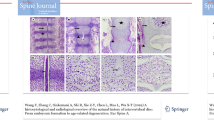Abstract
Using 15 mid-term human fetuses, we examined the role of the spine anterior and posterior longitudinal ligaments (ALL, PLL) in ossification of the lumbar vertebral body. By 18 weeks, a pair of calcified tissue or cortical walls had developed on the anterior and posterior sides of the ossification center. These calcified cortical walls were more highly eosinophilic than trabecular or woven bone in the ossification center. Vimentin-positive osteoblasts were arranged in line along the outer surface of the walls. However, few CD68-positive osteoclasts were evident around the walls, suggesting that the calcification in the walls was similar to periosteal ossification. The anterior cortical wall was connected tightly with the ALL by fiber bundles, but the posterior wall was separated from the PLL by the basivertebral (central) vein and loose tissues. Notably, by 30 weeks, the anterior cortical wall had become attached to and incorporated into the ALL. Thus, the ALL seemed to act as an active periosteum for ossification. Although our materials were limited in number and stage, we hypothesized that, in contrast to the PLL, the mature anterior cortical wall corresponds to a calcified fibrocartilage adjacent to the ALL and forms a bone–ligament interface maintaining an ossification potential.





Similar content being viewed by others
References
Bareggi R, Grill V, Zweyer M et al (1994) A quantitative study on the spatial and temporal ossification patterns of vertebral centra and neural arches and their relationship to the fetal age. Ann Anat 176(4):311–317
Baydar D, Amin MB, Epstein JI (2006) Osteoclast-rich undifferentiated carcinomas of the urinary tract. Mod Pathol 19(2):161–171
Benjamin M, Ralphs JR (1998) Fibrocartilage in tendons and ligaments—an adaptation to compressive load. J Anat 193(Pt 4):481–494
Benjamin M, Toumi H, Ralphs JR et al (2006) Where tendons and ligaments meet bone: attachment sites (enthesis) in relation to exercise and/or mechanical load. J Anat 208(4):471–490
Benjamin M, Toumi H, Suzuki D et al (2009) Evidence for a distinctive pattern of bone formation in enthesophytes. Ann Rheum Dis 68(6):1003–1010
Bland YS, Ashhurst DE (1997) Fetal and postnatal development of the patella, patellar tendon and suprapatella in the rabbit; changes in the distribution of the fibrilar collagens. J Anat 190(Pt 3):327–342
Chano T, Matsumoto K, Ishizawa M et al (1996) Analysis of the presence of osteocalcin, S-100 protein, and proliferating cell nuclear antigen in cells of various types of osteosarcomas. Eur J Histochem 40(3):189–198
Doktorov AA, Denisov-Nikol'skiĭ IuI (1993) Involvement of the anterior longitudinal ligament of the spine in the morphogenesis of osteophytes in spondylosis deformans. Arkh Pathol 55(6):61–65
Duarte WR, Shibata T, Takenaga K et al (2003) S100A4: a novel negative regulator of mineralization and osteoblast differentiation. J Bone Miner Res 18(3):493–501
Hamid M, Fallet-Bianco C, Delmas V et al (2002) The human lumbar anterior epidural space: morphological comparison in adult and fetal specimens. Surg Radiol Anat 24(3–4):194–200
Hayashi K, Yabuki T, Kurokawa T et al (1977) The anterior and the posterior longitudinal ligaments of the lower cervical spine. J Anat 124(Pt 3):633–636
Jeong YJ, Cho BH, Kinugasa Y et al (2009) Fetal topohistology of the mesocolon transversum with special reference to the fusion with other mesenteries and fasciae. Clin Anat 22(6):716–729
Loughenbury PR, Wadhwani S, Soames RW (2006) The posterior longitudinal ligament and peridural (epidural) membrane. Clin Anat 19(6):487–492
Melrose J, Smith S, Ghosh P et al (2003) Perlecan, the multidomain heparan sulfate proteoglycan of basement membranes, is also a prominent component of the cartilaginous primordia in the developing human fetal spine. J Histochem Cytochem 51(10):1331–1341
Neumann P, Ekström LA, Keller TS et al (1994) Aging, vertebral density, and disc degeneration alter the tensile stress–strain characteristics of the human anterior longitudinal ligament. J Orthop Res 12(1):103–112
Papalas JA, Balmer NN, Wallace C et al (2009) Ossifying dermatofibroma with osteoclast-like giant cells: report of a case and literature review. Am J Dermatopathol 31(4):379–383
Shapiro F, Cahill C, Malatantis G et al (1995) Transmission electron microscopic demonstration of vimentin in rat osteoblast and osteocyte cell bodies and processes using immunogold technique. Anat Rec 241(1):39–48
Skawina A, Litwin JA, Gorczyca J et al (1997) The architecture of internal blood vessels in human fetal vertebral bodies. J Anat 191(Pt 2):259–267
Soames RW (1995) Skeletal system. In: Williams PL (ed) Gray’s anatomy. Churchill Livingstone, London, pp 425–736
Tanaka N, Tsuchiya T, Shiokawa A et al (1986) Histopathological studies of the osteophytes and ossification of the posterior longitudinal ligament (OPLL) in the cervical spine. Nippon Seikeigeka Gakkai Zasshi 60(3):323–336
Verbout AJ (1985) The development of the vertebral column. Adv Anat Embryol Cell Biol 90:1–122
Watanabe H, Miake K, Sasaki J (1993) Immunohistochemical study of the cytoskeleton of osteoblasts in the rat calvaria. Intermediate filaments and microfilaments as demonstrated by detergent perfusion. Acta Anat 147(1):14–23
Xian CJ, Zhou FH, McCarty RC et al (2004) Intramembranous ossification mechanism for bone bridge formation at the growth plate cartilage injury site. J Orthop Res 22(2):417–426
Acknowledgments
This study was supported by a grant (0620220-1) from the National R&D Program for Cancer Control, Ministry of Health and Welfare, Republic of Korea.
Author information
Authors and Affiliations
Corresponding author
Rights and permissions
About this article
Cite this article
Jin, Z.W., Song, K.J., Lee, N.H. et al. Contribution of the anterior longitudinal ligament to ossification and growth of the vertebral body: an immunohistochemical study using the human fetal lumbar vertebrae. Surg Radiol Anat 33, 11–18 (2011). https://doi.org/10.1007/s00276-010-0725-2
Received:
Accepted:
Published:
Issue Date:
DOI: https://doi.org/10.1007/s00276-010-0725-2



